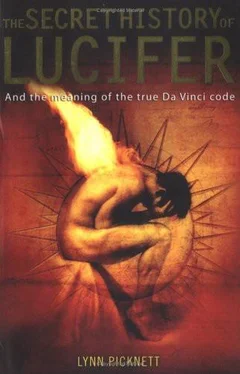Inherently unclean
Excavating beneath the story of the original witchfinders and the thoughts of Summers, the full horror of a world gone mad is revealed. But it is more even than that: it is a living nightmare where the torturers and killers do so in the name of the highest good, and the `evil' accused are, for the most part, utterly innocent of all great wrong. This was truly a time when Satan walked the earth - in the guise of the God of Love.
While there will undoubtedly be many who object to the witch trials being depicted as primarily a sustained outrage against women, there is no doubt whatever that the witch hysteria `provided a focus for sexist hatred in male-dominated society'.51 It had not escaped the notice of the Inquisition that the hated Cathars practised an almost unique form of spiritual egalitarianism of the sexes, and that their influence had helped foster a great flowering of secular arts in the south of France, including the artful songs of the Troubadours, and the cult of the Lady - clearly a resurrection of ancient goddess worship. (The Troubadour's insistence of loving individual women was quite new to most people - nothing in the classical world was remotely similar.) Everywhere they looked in the Languedoc and Provence, the men of the Church must have blanched at the unavoidable echoes of the unacceptable `Apostle of the Apostles' - Mary Magdalene, whose memory they were so eager to malign, and whose cult they were intent on destroying.
It must not be forgotten that women, whether accused of witchcraft or not, were widely believed - certainly by the Church patriarchy - to be naturally polluted and unclean. In this, they accepted the Rabbinical tradition that claimed Eve first menstruated only after she had fornicated with the snake - her firstborn, Cain, being widely seen as the child of the serpent, not Adam. Today orthodox Jews refuse to shake hands with a woman in case she is menstruating, while rural communities across Europe still hold that a woman with her period will turn milk or wine sour and blunt knives. Saint Jerome thundered `Nothing is so unclean as a woman in her periods; what she touches she causes to become unclean.' In the seventh century, Bishop Theodore of Canterbury forbade menstruating women to take communion or even enter a church - as did the French synod of Meaux. Even in the twentieth century a Scottish medical textbook quoted the old rhyme: `Oh! Menstruating woman, thou'rt a fiend/From which all nature should be closely screened.'S2 As Barbara Walker points out, religious women especially were ordered to detest their own bodies, citing the Rule for Anchoresses: `Art thou not formed of foul slime? Art thou not always full of uncleanness?"'
The association between the vileness of `witchcraft' and menstruation was reinforced as far as the Montague Summers of this world were concerned by the - admittedly extreme - rites of Gnostic groups such as the Ophites and the Carpocratians (whom we have discussed previously). When reading the following passage by Epiphanius, it is instructive to recall that the Carpocratians claimed to have received sexual secrets (akin to those of the Ophites) from Salome, Martha and Mary Magdalene - and that Saint Clement confessed that he knew this to be true.
... the wretches mingle with each other ... after they have consorted together in a passionate debauch ... The woman and the man take the man's ejaculation into their hands, stand up ... offering to the Father, the Primal Being of All Nature, what is on their hands, with the words, `We bring to Thee this oblation, which is the very Body of Christ'.
... They consume it, take housel of their shame and say: `This is the Body of Christ, the Paschal Sacrifice through which our bodies suffer and are forced to confess the sufferings of Christ.' And when the woman is in her period, they do likewise with her menstruation. The unclean flow of blood, which they garner, they take up in the same way and eat together. And that, they say, is Christ's Blood. For when they read in Revelation, `I saw the tree of life with its twelve kinds of fruit, yielding its fruit each month,54 they interpret this as an allusion to the monthly incidence of the female period.55
Clearly Evensong was once rather more colourful than it is today. However, as we shall see, devotees of the Black Mass revived the sacrament of the semen and menstrual blood, although they may not actually have realized that they were reinstating an original Christian ritual (if, indeed, the Carpocratians, Simon Magus and Clement of Alexandria were right). Perhaps they merely wanted to shock. In any case, this sort of rite is also found in Tantrism, where consuming the living substances of sex and reproduction were believed to be of a higher kind of spirituality than eating the dead god, even when transubstantiated into, or represented by, the bread and wine - `although the colour symbolism was the same' .56 (Interestingly, both Catholics and the later Protestants denounced witches as cannibals.)
To the Tantrics, the officiating priestesses, who were expected to menstruate in order to benefit from the extra flow of lunar power, were symbolized by the colour red. Is this why Mary Magdalene was traditionally portrayed as boasting a thick red mane of hair, despite the fact that as an Egyptian or Ethiopian - or even, as widely supposed, a Judaean - her hair would have been extremely dark? And one must not forget that in the Middle Ages women with the symbolic red hair were believed to be witches, and often burnt as such.
It was long believed that demons were born of menstrual blood - including the legendary basilisk with the fatal look. However, not all cultures despised the monthly flux: `the very word taboo, from Polynesian tupua, "sacred, magical", applied specifically to menstrual blood.'57 And even some European peasants believed it had curative powers - stained rags scattered on fields were believed to bless them with greater fertility. But in general the western view was - and to a large extent, still is, one of abhorrence.
Both the Catholic and Anglican hierarchies of the late twentieth century argued against the ordination of women on the grounds that a menstruating woman would `pollute' the altar. Walker notes wryly: `This would not preclude ordination of post-menopausal women, but different excuses are found for those.' She adds: `The holy "blood of life" used to be feminine and real; now it is masculine and symbolic."'
In the Middle Ages certain areas associated with the Feminine were proscribed by the Church, including wells, groves and caves, all of which had become indelibly linked with goddess worship and which - unsurprisingly - became denounced as the haunt of witches and demons. Any similar place was categorized as cunnus diaboli, `devilish cunt', and was therefore avoided by all God-fearing folk.
After the Cathars and associated heretics were effectively erased from the map, the Inquisition's feeding frenzy needed more fuel, and what worse or more disgusting heretics were there than witches, actual self-confessed worshippers of Satan? How convenient, too, that most of the accused were women! As Mary Daly writes in her Beyond God the Father (1973):
The spirit of the Church in its contempt for women, as shown in the Scriptures, in Paul's epistles and the Pentateuch, the hatred of the fathers, manifested in their ecclesiastical canons, and in the doctrines of asceticism, celibacy, and witchcraft, destroyed man's respect for woman and legalized the burning, drowning, and torturing of women ...
Women and their duties became objects of hatred to the Christian missionaries and of alternate scorn and fear to pious ascetics and monks. The priestess mother became something impure, associated with the devil, and her lore an infernal incantation, her very cooking a brewing of poison, nay, her very existence a source of sin to man. Thus woman, as mother and priestess, became woman as witch ...59
Читать дальше












